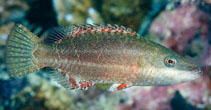| Family: |
Labridae (Wrasses), subfamily: Cheilininae |
| Max. size: |
40 cm SL (male/unsexed) |
| Environment: |
reef-associated; brackish; marine; depth range 3 - 60 m |
| Distribution: |
Indo-Pacific: Red Sea and East Africa to the Marshall Islands and Samoa. |
| Diagnosis: |
Dorsal spines (total): 9-9; Dorsal soft rays (total): 10-10; Anal spines: 3-3; Anal soft rays: 8-11. Differs from the very similar C. unifasciatus by always lacking the white bar in front of the caudal base as well as the area clear of red streaks extending from the eye to just above the pectoral axis (Ref. 1602). |
| Biology: |
Found solitary (Ref. 90102) in lagoon and sheltered seaward reefs in coral rich areas (Ref. 1602, 58652). Possibly to 120 m depths. Young is more inshore on sheltered reef crests or slopes, usually amongst soft corals or stinging hydrozoans (Ref. 48635). Feeds on hard-shelled mollusks, crustaceans, and sea urchins (Ref. 27550). The species is observed to swim with a group of goatfish and change its color to resemble these fish, it then darts out from the group to catch small fish (Ref. 2334). This species curiously approaches divers closely (Ref. 90102). |
| IUCN Red List Status: |
Least Concern (LC); Date assessed: 25 March 2009 Ref. (130435)
|
| Threat to humans: |
harmless |
Source and more info: www.fishbase.org. For personal, classroom, and other internal use only. Not for publication.
